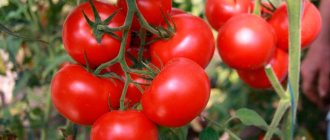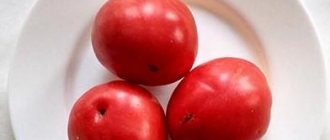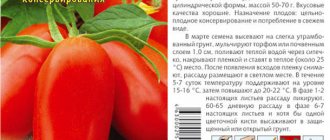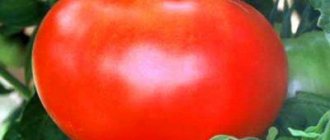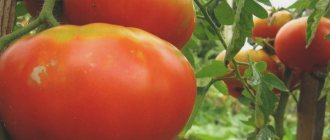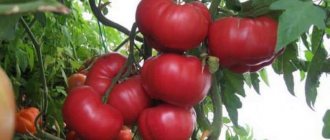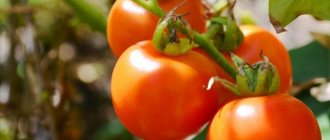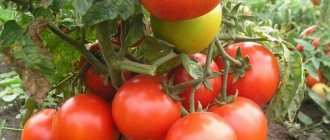Of all the variety of tomatoes, plum tomatoes are the most popular among summer residents. They have a pleasant appearance, excellent taste and are widely used in cooking. In addition, the varieties actively bear fruit and do not cause much trouble during the growing process. One of these unique ones is the Chio Chio San tomato. In addition to the unusual name, it has many positive qualities that have already been appreciated by summer residents from different parts of Russia and neighboring countries.
Tomatoes have a plum-like shape and a pleasant taste.
Description and characteristics of the variety Chio Chio San
The Chio Chio San tomato is an indeterminate type crop with a complex cluster structure. The height of the plant, without pinching the top, can reach up to 2.5 m. The first flower-fruit ovary is formed above the 9th leaf, then every 3 subsequent leaves. One brush can contain up to 50 berries. The variety is mid-season, the first harvest is harvested 100–120 days from the moment of germination.
Country of origin, year of registration
The variety Chio Chio San was bred in Russia in 1998 by agronomists. A year later, tomato seeds were included in the State Register of the country. The tomato was bred to meet the needs of summer residents and amateur gardeners. Agro breeders set themselves the task of creating a vegetable that was universal in cultivation and use.
On a note! The tomato is included in the State Register of the Russian Federation under the name Butterfly.
Growing regions
The varietal vegetable is immune to weather changes. The Chio Chio San tomato is suitable for cultivation in almost any climatic conditions. Regions favorable for the cultivation of nightshade crops include the territory of Moldova and Ukraine, the southern, central and northern parts of Russia.
Productivity and sustainability
The tomato variety Chio Chio San boasts high yields. From 1 m2 of planting you can expect up to 8 kg of vegetable products. With proper care, one plant produces 4 to 4.5 kg of berries. The fruits are small-fruited, plum-shaped, with an average berry weight of 35 g.
The color of ripe berries is pink. Ripe tomatoes tolerate transportation well and have a shelf life. The culture is resistant to late blight and other diseases inherent in tomato crops.
Method of use
The fruits of the Chio Chio San tomato have a dense structure and excellent taste characteristics. This is a versatile vegetable. Inside the berry there are 2 small seed chambers with a minimum number of small seeds. The pulp is fleshy, without visible liquid discharge. The tomato is suitable for fresh consumption, as an ingredient in vegetable salads, and canning.
Taste qualities
Reviews from gardeners completely coincide with the author’s description of taste data.
This tomato variety is really very tasty and sweet. The ratio of organic acids and sugars is so proportional that most people perceive it as a balanced and excellent taste. The tomato aroma is not very strong, but very noticeable with pleasant tomato notes.
When cut, the tomato fruit of this variety does not look very presentable. The seed chambers are filled with juice and contain many seeds. This quality affects tomato preparations. The peel and seeds are easily separated during heat treatment, but the abundance of seeds makes it necessary to filter the product carefully and repeatedly.
Tomato products after processing also have good reviews. The juice is homogeneous, sweet, quite thick, light red in color. Speaking about canned tomatoes, opinions are somewhat divided, but it all depends on the skill of the housewife and the time of heat treatment. Some argue that due to the thin skin, tomatoes burst and it is problematic to get them out of the jar intact, but it still requires some skill.
The main pros and cons of tomatoes
Positive qualities of the variety:
- high productivity;
- taste qualities;
- versatility;
- immunity to diseases;
- plant viability.
With all the positive aspects, there are also negative aspects of the variety. The plant requires constant care, which consists of forming a bush, tying up stems, and regular feeding. Another disadvantage is the tendency of ripe tomatoes to crack when watered abundantly. The harvest should be harvested in a timely manner; ripe berries are poorly preserved on the bush.
Flaws
Among the disadvantages it should be noted:
- since this tomato is a hybrid, it is impossible to collect seed material for subsequent planting;
- bushes of this variety do not tolerate sharp drops in air temperature;
- bushes require shaping and gartering; brushes also need to be tied up;
- if ripe fruits are left on the bushes, they may crack.
Related article:
Varieties of pink tomatoes Eagle beak and Eagle heart
Subtleties of growing tomatoes
Highly fertile, light soils are suitable for growing tomatoes. Favorable predecessors for nightshades are pumpkin crops, cabbage, onions, cucumbers and carrots. You should not use areas where potatoes, eggplants, peas and peppers previously grew for planting tomatoes. Growing of tomato crops is carried out using the seedling method.
See also Description and characteristics of the Alsou tomato variety
Seed preparation
You should buy seeds in specialized stores. Before sowing, planting material requires preparation, which consists of the following manipulations:
- Calibration - seeds are soaked in water and set aside for a short time. After 5 minutes, the water with the floating seeds is drained. The seeds that have sunk to the bottom are dried.
- Disinfection - calibrated seed material is soaked and kept in a solution of potassium permanganate. To prepare a disinfectant composition, 1 g of potassium permanganate is diluted in a liter of water. Seeds wrapped in gauze are kept in the solution for 15–20 minutes.
- Hardening - seeds are alternately exposed to high and low temperatures.
Container and soil
Soil preparation is an important stage in the process of growing vegetable seedlings. For sowing seeds, water- and air-permeable soil compositions are used. The ideal basis for sowing tomatoes is turf soil, half mixed with peat and humus. To reduce acidity, wood ash is added to the mixture at the rate of 200 grams per bucket of soil. Special trays or cassettes, plastic or wooden boxes are used as containers for growing seedlings.
Sowing
Sowing seeds for seedlings is carried out in March. The selected containers for sowing are filled with soil composition, the thickness of the soil layer is from 5 cm. The prepared seeds are placed in moistened soil to a depth of 1–2 cm. The containers are covered with film and left warm. The first seedlings appear on the 5th day after sowing. After germination of the seed, the film is removed.
Seedling care
Seedlings are cared for in accordance with key agrotechnical rules. Basic conditions for growing seedlings:
- regular moistening of the soil mixture;
- sufficient level of illumination;
- maintaining optimal air temperature and humidity;
- loosening the soil.
Expert opinion
Stanislav Pavlovich
Gardener with 17 years of experience and our expert
Ask a Question
Important! After the first pair of true leaves appear on the sprouts, the seedlings are plucked, that is, planted in individual containers with preliminary pinching off the main root by a third.
Transplantation to a permanent place
Seedlings are usually planted in May or June. Seedlings suitable for planting in a permanent place should reach a height of 20–35 cm. Good planting material should have a thick stem.
On a note! 10 days before planting in a permanent place, the seedlings are hardened.
Holes in the soil are prepared immediately before planting seedlings. Planting norms per 1 m2 of plot are from 3 to 5 bushes. The distance between the rows is 60–70 cm, the bushes in the row are planted at a distance of 45–60 cm from each other.
Further care for adult bushes
As the stem grows, shoots are tied to trellises or stakes. Starting from the second half of July, the shoots are removed from the lower part of the bush and the tops of the plants are plucked off. To obtain a good harvest, it is necessary to provide the plant with proper agrotechnical care, which includes:
- watering;
- loosening;
- mulching;
- application of fertilizers.
Watering rules
As a rule, watering the bushes is carried out as the soil dries, no more than 2-3 times a week. The irrigation schedule is adjusted depending on weather conditions. In rainy weather, watering is stopped. The frequency of watering is also influenced by the location where the crop is grown. Greenhouse plants are watered less often than bushes growing in open ground. In greenhouse conditions, it is better to water the plants in the evening with water heated under the sun's rays.
See also Description, characteristics and nuances of growing red banana tomato
Loosening the soil
Loosening the soil between the rows is carried out in order to provide air access to the root system of the plant. Agrotechnical methods are carried out on the second day after watering or precipitation, when the soil dries out a little. The first loosening is carried out 10–12 cm deep. As the bush grows, in order not to damage the root system, the tillage depth is reduced to 5–8 cm.
Mulching
Covering the soil surface with a layer of mulch is used to protect the roots and maintain moisture and porosity of the soil around the bush. Mulching not only simplifies the care of tomato crops, but also serves as a protective layer against diseases that occur when the green part of the plant comes into contact with the soil. Organic substances are used as covering material - sawdust, straw, pine needles, as well as synthetic agrofibre.
Fertilizing
The first feeding of tomato crops is carried out 14–20 days after planting the seedlings in the beds. In total, fertilizing is applied 4 to 5 times during the season. For feeding, organic and mineral fertilizers are used, which are applied alternately. Fertilizers are applied 10–14 days after watering.
Why is there no ovary
- Seeds collected from hybrid tomatoes. If tomatoes of hybrid forms were sown and seeds were collected from them, then there will be abundant flowering, but there will be no fruit. Hybrids do not produce offspring.
- Unsuitable variety for specific growing area. Before buying seeds, be sure to look at what zone the variety is intended for and how to grow it. Seeds should be purchased exclusively taking into account climatic conditions.
- Lack of timely feeding. A lack of minerals in the soil can cause a lack of fruit. Potassium-phosphorus fertilizers should be added to the soil, especially during the period of tomato planting.
Nuances for open ground and greenhouse conditions
Chio Chio San tomatoes demonstrate high productivity rates both when grown in open beds and in greenhouse conditions. Seedlings are planted in open ground after the end of spring frosts; seedlings are planted in a greenhouse starting from the end of April. An important nuance when growing in greenhouse conditions is maintaining temperature and humidity conditions. To avoid damage to the bushes by pests, you should regularly ventilate the greenhouse.
Pests and diseases of mid-season tomato
The tomato variety Chio Chio San is characterized by high resistance to various diseases. In order to prevent the development of fungal diseases, 14 days after planting seedlings in a permanent place, the bushes are treated with Bordeaux mixture. The main danger to the plant are pests that cause damage to the root system and foliage. Tomato crops are susceptible to attack by whiteflies, nematodes and spider mites. Insecticides are used to control pests, for example, Fitoverma and Atellika.

